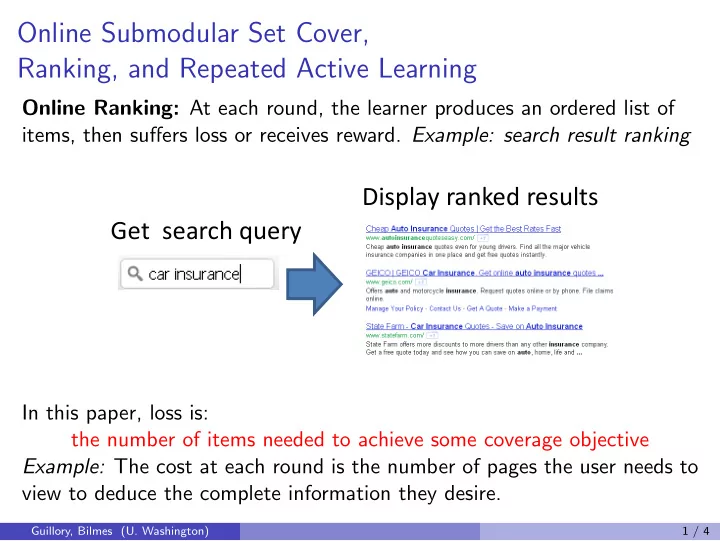

Online Submodular Set Cover, Ranking, and Repeated Active Learning Online Ranking: At each round, the learner produces an ordered list of items, then suffers loss or receives reward. Example: search result ranking Display ranked results Get search query In this paper, loss is: the number of items needed to achieve some coverage objective Example: The cost at each round is the number of pages the user needs to view to deduce the complete information they desire. Guillory, Bilmes (U. Washington) 1 / 4
Online Submodular Set Cover, Ranking, and Repeated Active Learning Repeated Active Learning is an interesting special case where the list consists of questions to ask or tests to perform. Example: diagnosis Visited by patient Perform series of tests Here a reasonable loss is the number of the tests we need to perform before we can make a accurate diagnosis. Guillory, Bilmes (U. Washington) 2 / 4
Online Submodular Set Cover, Ranking, and Repeated Active Learning For these applications we propose a new online learning problem we call online submodular set cover . At round t we pick a sequence S t = v 1 , v 2 , . . . v n . A monotone, submodular objective F t is then revealed. We pay cost equal to the cover time of F t : the minimum value c ∈ { 1 , 2 , . . . n } such that F t ( � c i =1 { v i } ) ≥ 1. Example: F t ( S ) is proportional to the number of candidate diseases eliminated by the set of tests S . Related but not equivalent to online submodular maximization and online min-sum submodular set cover (Streeter and Golovin, 2008) Guillory, Bilmes (U. Washington) 3 / 4
Online Submodular Set Cover, Ranking, and Repeated Active Learning Our results: A low-regret algorithm for online submodular set cover, building on a recent offline algorithm of Azar and Gamzu. Extensions to handle multiple objectives, partial information, context. Experimental results on synthetic data and a movie recommendation repeated active learning problem. Guillory, Bilmes (U. Washington) 4 / 4
Recommend
More recommend